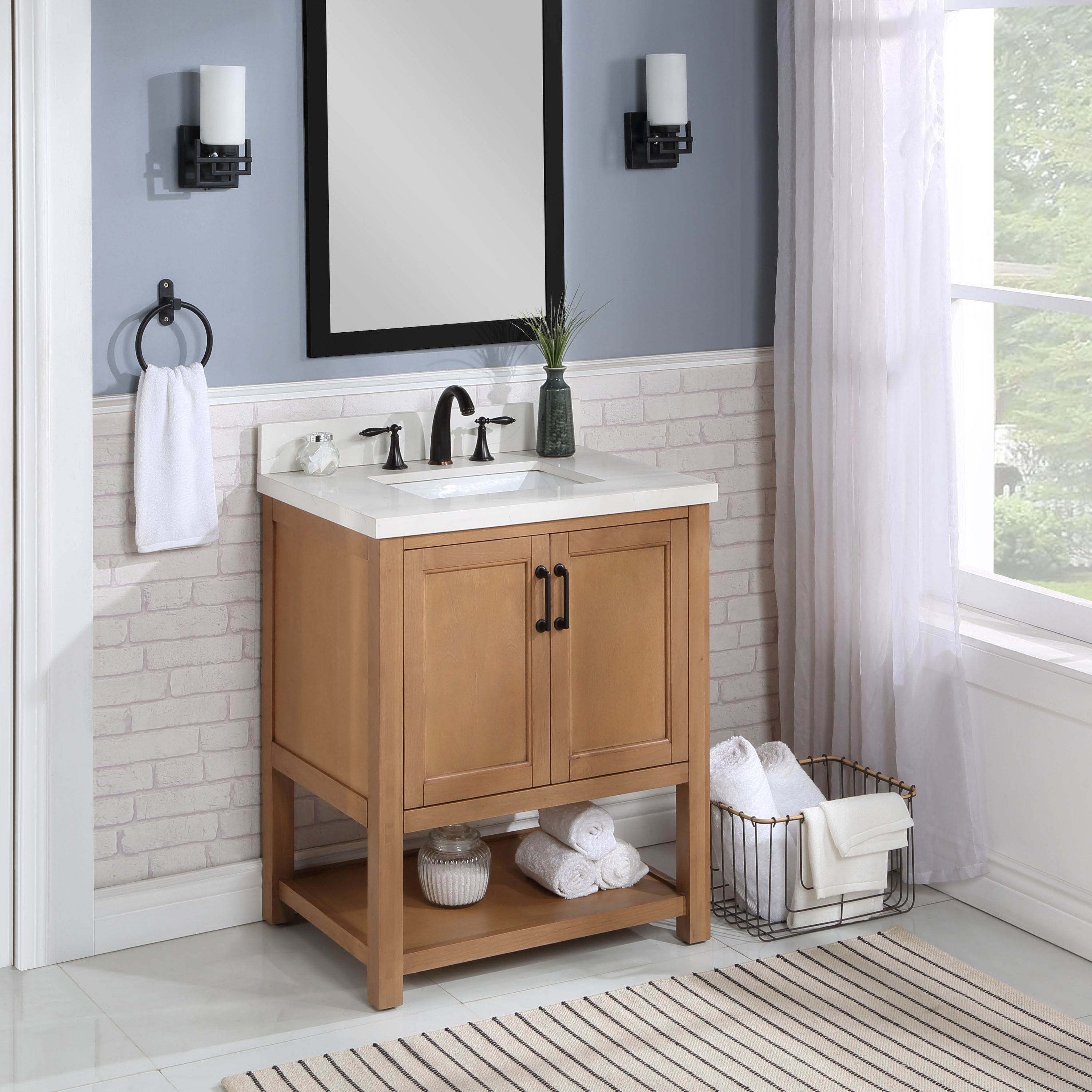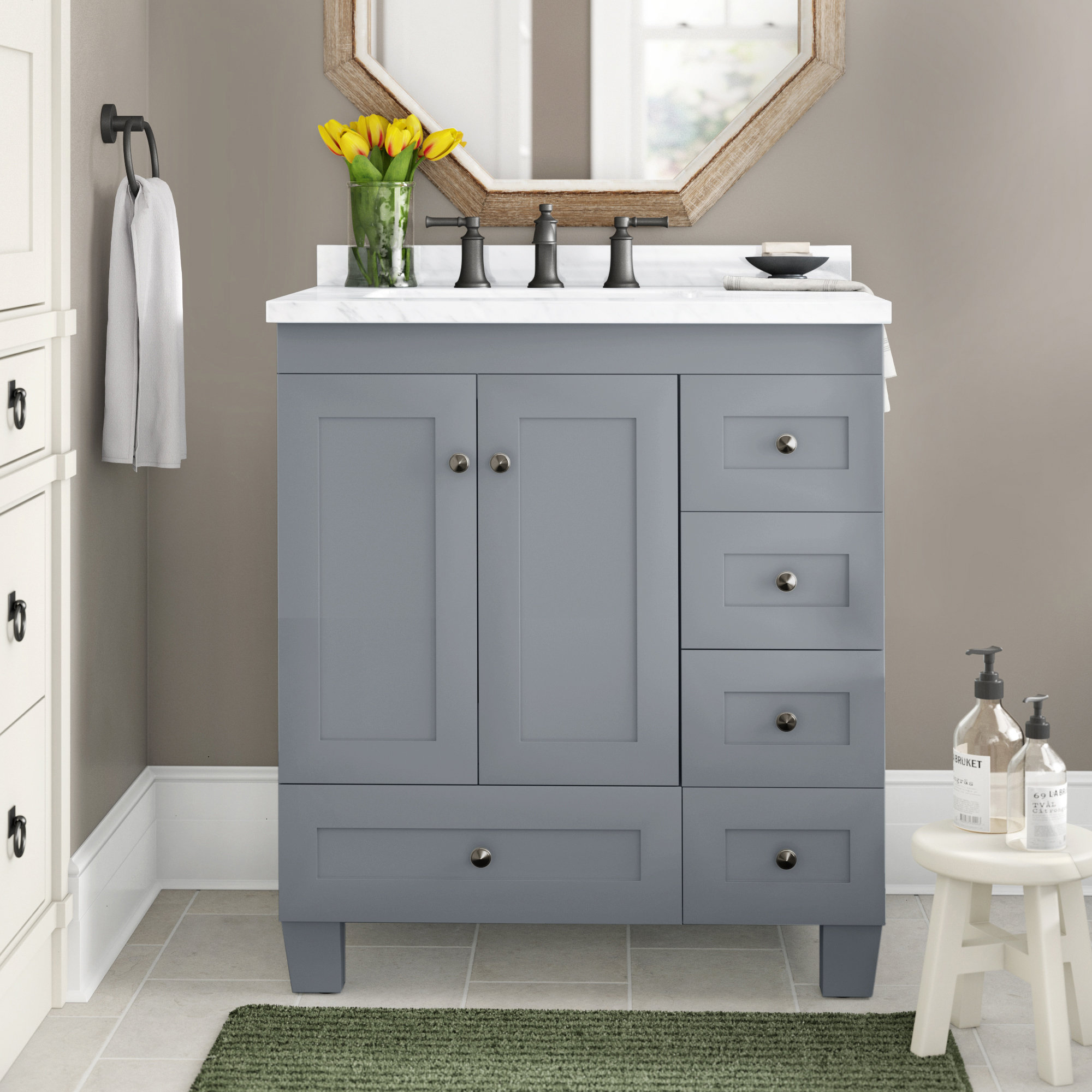Planning Your 30-Inch Bathroom Vanity: 30 Bathroom Vanity Plans

A 30-inch bathroom vanity is a popular choice for smaller bathrooms or powder rooms, offering a balance of functionality and space-saving design. Choosing the right 30-inch vanity for your bathroom involves considering various factors to ensure it fits your needs and complements your existing decor.
Vanity Styles
The style of your vanity should align with the overall aesthetic of your bathroom.
- Traditional vanities often feature ornate details, such as carved wood, decorative hardware, and classic designs. They exude a timeless elegance and work well in bathrooms with traditional or farmhouse decor.
- Modern vanities prioritize clean lines, minimalist designs, and sleek finishes. They are typically made from materials like metal, glass, or high-gloss laminate, and are ideal for contemporary or minimalist bathroom styles.
- Transitional vanities bridge the gap between traditional and modern styles. They feature elements of both, creating a balanced and versatile look that suits a wide range of bathroom aesthetics.
Essential Features to Consider
When selecting a 30-inch vanity, several key features should be considered:
- Sink Type: 30-inch vanities can accommodate a variety of sink types, including single-bowl, double-bowl, and vessel sinks. Single-bowl sinks are common in smaller vanities, while double-bowl sinks offer more workspace. Vessel sinks add a touch of elegance and can be integrated into both traditional and modern designs.
- Storage Options: Storage is crucial in any bathroom. 30-inch vanities often feature drawers, cabinets, or a combination of both. Consider your storage needs and choose a vanity with sufficient storage space for toiletries, towels, and other bathroom essentials.
- Countertop Material: The countertop material influences the overall look and durability of the vanity. Popular options include granite, marble, quartz, laminate, and solid surface materials. Each material offers unique characteristics in terms of appearance, durability, and maintenance requirements.
Measurements and Considerations
Accurate measurements are essential to ensure the chosen vanity fits your bathroom space effectively. Here’s a checklist of measurements and considerations:
- Vanity Width: Ensure the 30-inch vanity fits comfortably within your bathroom space, leaving enough room for movement and access to other fixtures.
- Vanity Depth: Consider the depth of the vanity, especially if space is limited. A deeper vanity might provide more storage but could encroach on bathroom space.
- Sink Bowl Size: If you choose a double-bowl sink, ensure the bowl size is adequate for your needs. Consider the size of your bathroom sink fixtures and how they will fit within the sink bowl.
- Countertop Height: The countertop height should be comfortable for use. Standard countertop height is typically 36 inches, but you may adjust it based on your personal preference.
- Faucet Clearance: Measure the distance from the countertop to the ceiling to ensure sufficient clearance for your chosen faucet.
- Door and Window Clearance: Ensure the vanity is placed in a location that allows for easy door and window opening and closing.
Bathroom Vanity Placement
- A 30-inch vanity is typically placed along a wall in a bathroom, often opposite the toilet. This placement maximizes space and creates a balanced layout.
- The vanity should be positioned at least 24 inches away from the toilet to allow for comfortable movement.
- Consider placing the vanity under a window for natural light and ventilation. However, ensure the vanity is not directly in front of the window, as this can obstruct light and create a cramped feel.
Popular 30-Inch Bathroom Vanity Designs

A 30-inch bathroom vanity offers a compact and stylish solution for smaller bathrooms, providing ample storage and a sleek aesthetic. The design possibilities for a 30-inch vanity are diverse, catering to various preferences and bathroom styles.
Popular 30-Inch Vanity Designs
There are several popular 30-inch vanity designs that cater to different aesthetics and functional needs.
- Modern: These vanities often feature clean lines, minimalist details, and sleek finishes. They typically incorporate materials like chrome, stainless steel, and high-gloss laminates.
- Traditional: Traditional vanities embrace classic design elements, such as ornate carvings, intricate hardware, and warm wood tones. They often feature a pedestal base or a more elaborate cabinet structure.
- Transitional: Transitional vanities blend modern and traditional elements, creating a harmonious and timeless aesthetic. They often feature simple lines, natural wood finishes, and understated hardware.
- Farmhouse: Farmhouse vanities often feature rustic elements, such as distressed wood, open shelving, and hardware with a vintage feel. They typically have a simple, functional design that complements the farmhouse aesthetic.
Materials Used for 30-Inch Bathroom Vanities
The material used for a 30-inch bathroom vanity significantly impacts its durability, aesthetics, and price.
- Wood: Wood vanities are known for their durability, natural beauty, and timeless appeal. They can be stained or painted to match any decor. Common wood choices include oak, maple, cherry, and walnut. However, wood vanities can be more expensive than other materials.
- Laminate: Laminate vanities offer a more affordable alternative to wood, providing a durable and moisture-resistant surface. They are available in a wide range of colors and patterns, mimicking the look of natural materials like wood or stone.
- Acrylic: Acrylic vanities are known for their sleek, high-gloss finish and resistance to moisture and stains. They are also relatively easy to clean and maintain. However, acrylic can be more susceptible to scratches than other materials.
Key Design Elements of a 30-Inch Bathroom Vanity
Several design elements contribute to the functionality and aesthetic appeal of a 30-inch bathroom vanity.
- Storage: A 30-inch vanity should offer sufficient storage space for toiletries, towels, and other bathroom essentials. Consider the number of drawers, shelves, and cabinets required for your needs.
- Sink: The sink should be proportionate to the vanity size and provide adequate space for washing hands and brushing teeth. Popular options include undermount, vessel, and drop-in sinks.
- Countertop: The countertop material should be durable, moisture-resistant, and easy to clean. Popular options include granite, marble, quartz, and laminate.
- Hardware: The hardware, including knobs, pulls, and faucets, should complement the vanity’s style and enhance its functionality. Consider the material, finish, and design of the hardware when making your selection.
Examples of 30-Inch Bathroom Vanity Designs
Here’s a table showcasing various 30-inch vanity designs, including their dimensions, materials, and price ranges:
| Design | Dimensions (W x D x H) | Material | Price Range |
|---|---|---|---|
| Modern White Vanity with Undermount Sink | 30″ x 18″ x 34″ | Laminate | $300 – $500 |
| Traditional Oak Vanity with Double Drawers | 30″ x 22″ x 36″ | Oak | $600 – $900 |
| Transitional Gray Vanity with Vessel Sink | 30″ x 19″ x 32″ | Acrylic | $400 – $700 |
| Farmhouse White Vanity with Open Shelving | 30″ x 20″ x 35″ | Distressed Wood | $500 – $800 |
Installing a 30-Inch Bathroom Vanity

Installing a 30-inch bathroom vanity is a straightforward project that can significantly upgrade your bathroom’s aesthetic and functionality. With the right tools and careful planning, you can successfully install a vanity and enjoy its benefits.
Tools and Materials Required
Before starting the installation, ensure you have all the necessary tools and materials. This will make the process smoother and prevent unnecessary delays.
- Vanity: Choose a vanity that fits your bathroom space and style preferences.
- Level: A level is crucial for ensuring the vanity is installed straight and securely.
- Measuring tape: Used for accurate measurements to ensure proper fitting.
- Pencil: For marking the wall for vanity placement and drilling locations.
- Drill: Necessary for drilling pilot holes and securing the vanity to the wall.
- Screwdriver: For assembling the vanity and attaching hardware.
- Stud finder: To locate wall studs for secure anchoring of the vanity.
- Safety glasses: To protect your eyes from debris during drilling and hammering.
- Caulk: To seal gaps between the vanity and the wall, preventing water damage.
- Plumber’s tape: To ensure tight connections for the plumbing fixtures.
- Adjustable wrench: For tightening and loosening plumbing connections.
- Pliers: For manipulating plumbing fixtures and wires.
- Wire strippers: To expose the wires for electrical connections.
- Electrical tape: To secure electrical connections and prevent shorts.
- Gloves: To protect your hands from sharp edges and potential hazards.
Preparing the Installation Area
Preparing the installation area is crucial for a smooth and successful installation. This includes clearing the area, checking the plumbing and electrical connections, and ensuring the wall is ready for the vanity.
- Clear the Area: Remove any existing vanities, mirrors, or fixtures that may obstruct the installation process.
- Check Plumbing Connections: Inspect the existing plumbing connections for leaks or damage. If necessary, repair or replace the pipes and ensure they are properly sealed.
- Check Electrical Connections: Ensure the electrical outlet is working and is located in a convenient position for the vanity. If necessary, hire an electrician to relocate or install a new outlet.
- Prepare the Wall: Clean the wall surface to remove dirt, dust, or debris. Ensure the wall is smooth and free from unevenness. If needed, apply a layer of primer or paint to prepare the surface for the vanity.
Installing the Vanity, 30 bathroom vanity plans
Installing the vanity involves securing it to the wall, connecting the plumbing, and connecting the electrical components.
- Position the Vanity: Place the vanity against the wall where you intend to install it. Use a level to ensure it is perfectly straight. Mark the wall with a pencil where the vanity will be secured.
- Secure the Vanity to the Wall: Using a stud finder, locate wall studs for securing the vanity. Drill pilot holes at the marked locations and use appropriate screws to attach the vanity to the wall. Ensure the screws are long enough to penetrate the wall studs for secure anchoring.
- Connect the Plumbing: Attach the vanity’s plumbing fixtures to the existing pipes. Use plumber’s tape on the threads to prevent leaks. Tighten the connections with an adjustable wrench, but avoid overtightening, which can damage the fixtures.
- Connect the Electrical: Connect the vanity’s electrical components to the outlet. Use wire strippers to expose the wires and connect them to the outlet’s terminals. Secure the connections with electrical tape. Ensure the wiring is done according to local electrical codes.
- Caulk and Finish: Apply caulk around the base of the vanity to seal any gaps between the vanity and the wall. This prevents water damage and improves the aesthetics of the installation.
